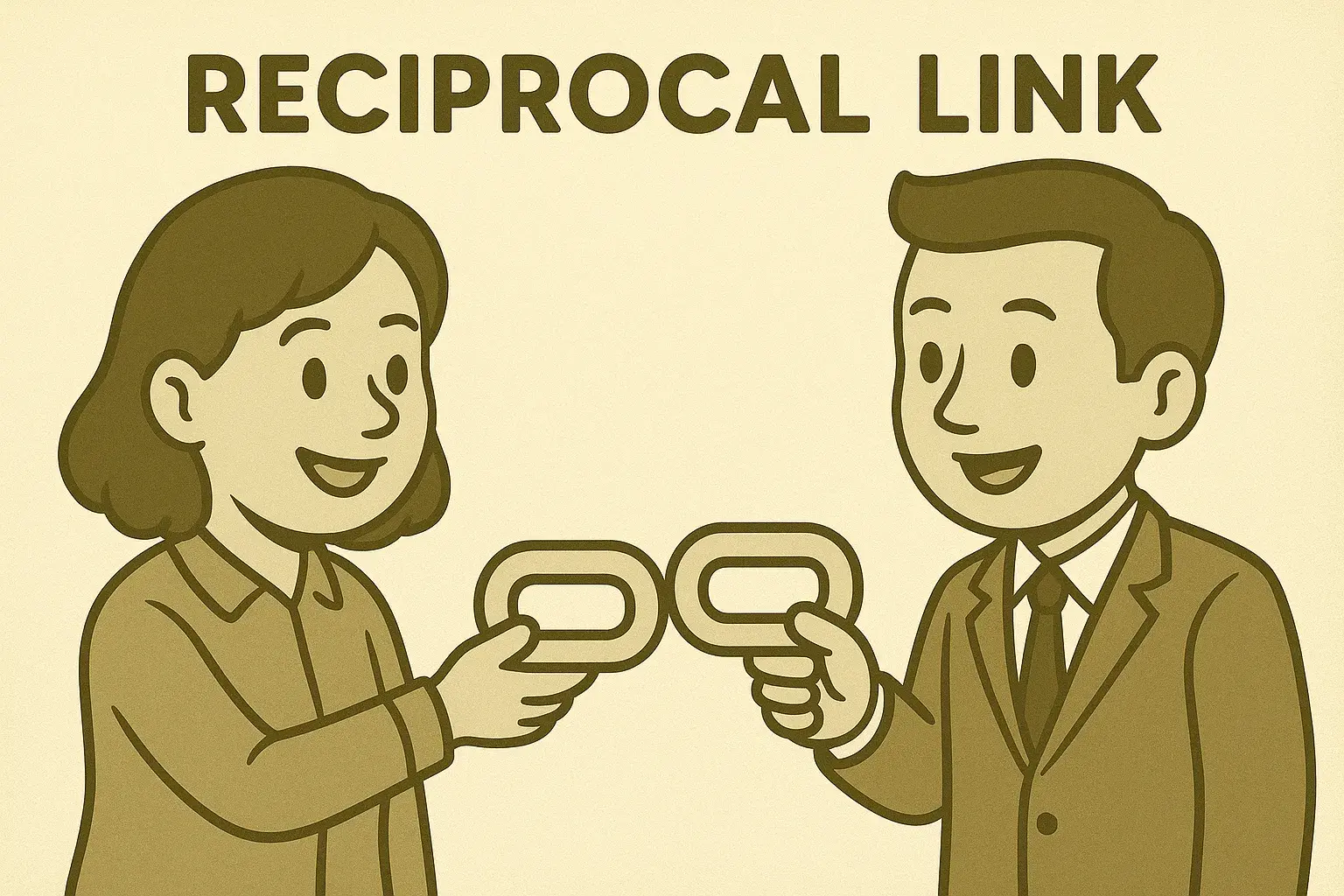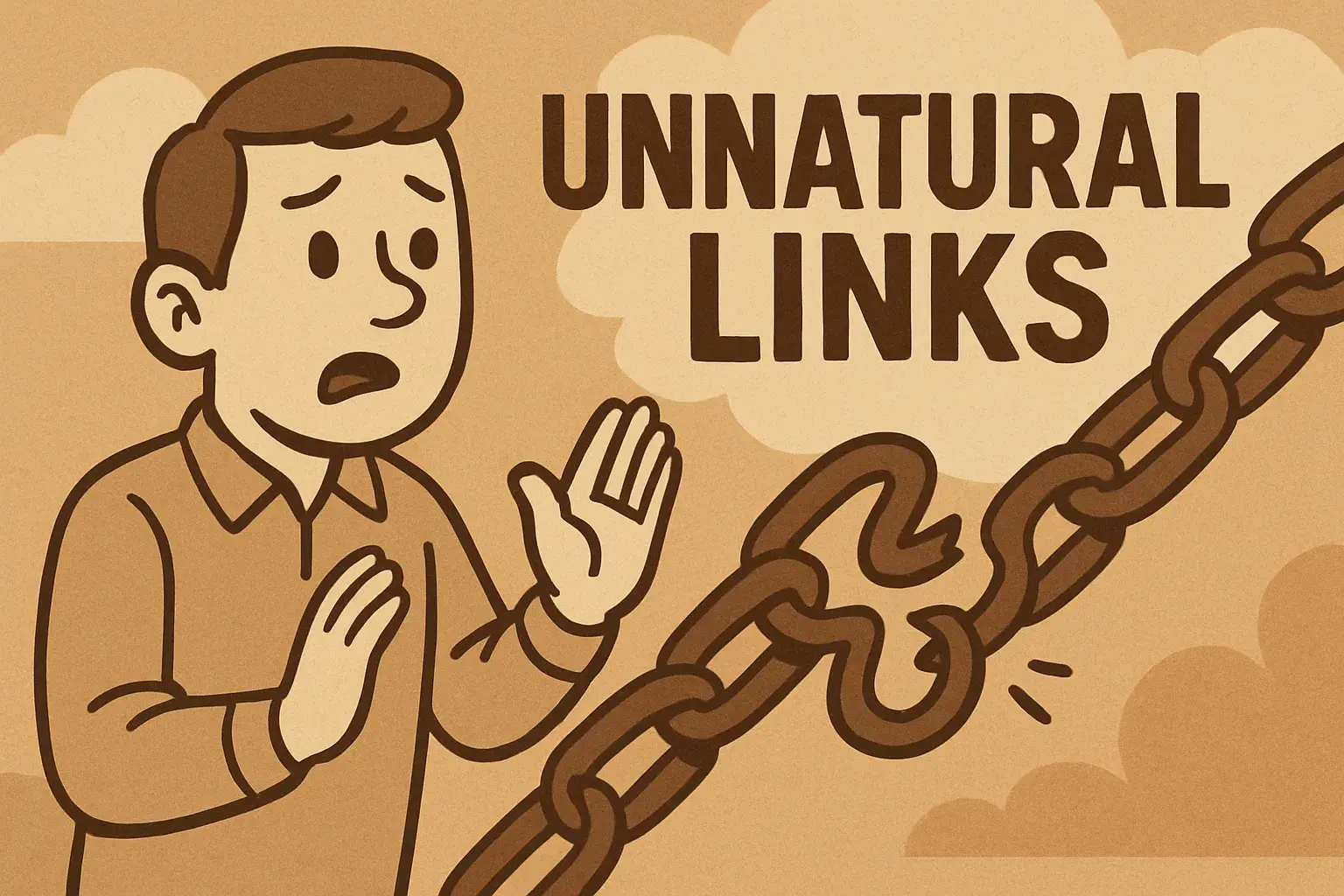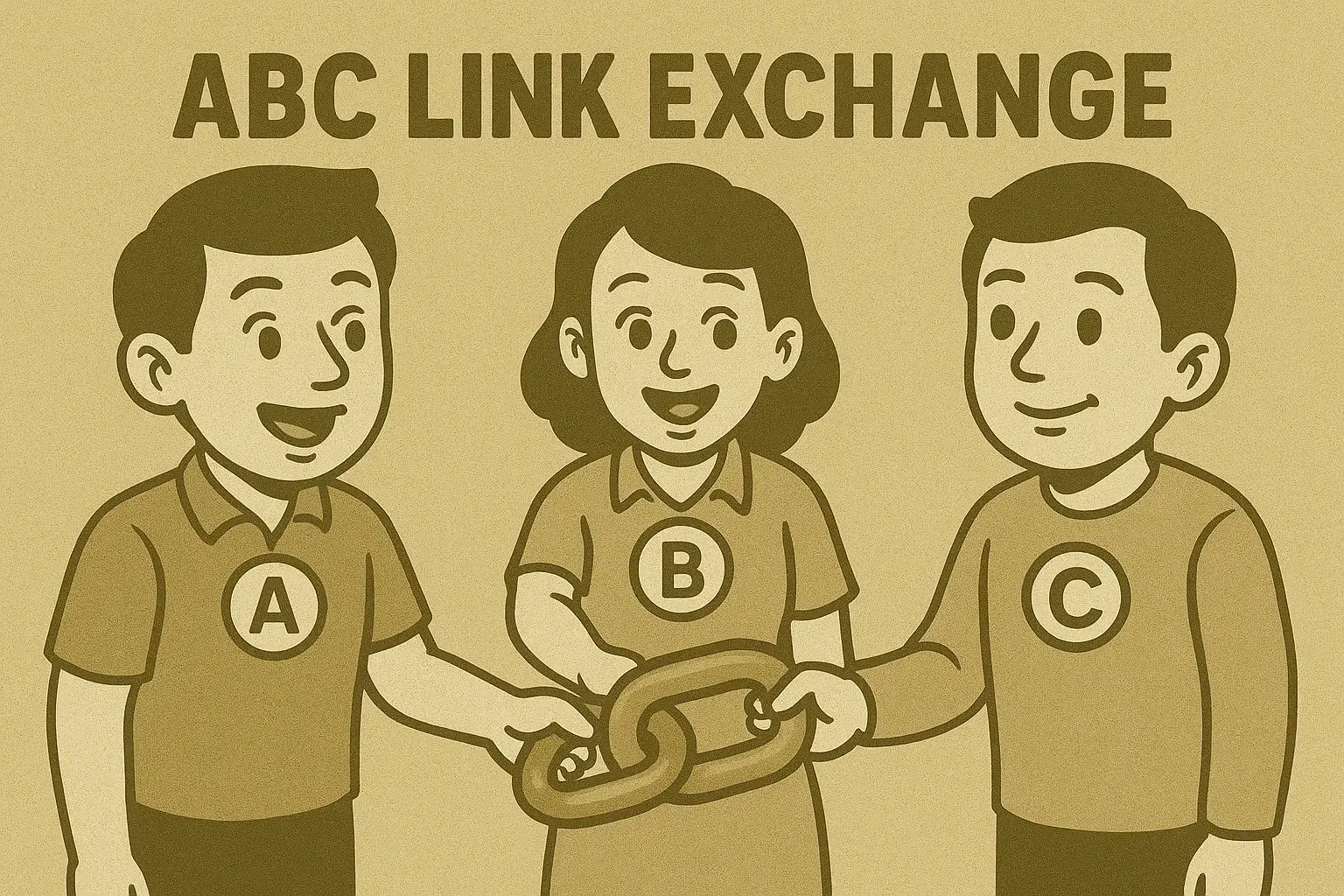What Is a Reciprocal Link Exchange?

Reciprocal link exchanges have been part of SEO since the early days of search.
In simple terms, a reciprocal link is when two websites agree to link to each other. Site A links to Site B, and Site B links back to Site A – essentially “You link to me, and I’ll link to you.”
This arrangement is often called a link exchange, link swap, or traded link. While the concept sounds straightforward – almost like swapping favors – its role in SEO has evolved significantly over time.
Understanding what reciprocal linking means, why website owners do it, and how search engines view it today is crucial for link building professionals.
In this article, we’ll explore the definition and history of reciprocal link exchanges with real examples. We’ll analyze their potential SEO value and benefits, but also dive into the risks and nuances, especially in light of Google’s policies and algorithm updates over the years. Importantly, we won’t paint reciprocal linking as inherently bad or good – instead, we’ll take an objective look at when it can help, when it can hurt, and how to approach it safely in 2025.
What are reciprocal link exchanges
A reciprocal link exchange is an arrangement where two sites intentionally link to each other, usually with the hope of mutual benefit of growing domain authority or traffic.

This is an agreement: “I’ll put a link to your site on my resources page if you do the same for me.”
Historically, webmasters would often have a “Links” or “Partners” page listing dozens of exchanged links. The underlying idea was that if inbound links help rankings, exchanging links would boost both sites’ SEO authority.
It’s important to distinguish between natural reciprocal links and planned link exchanges. Reciprocal links can occur organically without any prior agreement.
For example, Site A might link to a useful blog post on Site B purely as a helpful resource for readers. Later, Site B, perhaps impressed by Site A’s content, links back organically. This is a reciprocal link by coincidence, not by contract.
In contrast, a true “link exchange” usually implies a deliberate deal. Both scenarios result in two-way links, but one is a natural editorial choice and the other is a strategic swap.
To illustrate, imagine you run a travel blog and frequently cite data from a tourism statistics website. One day, that tourism site notices your mentions and decides to add your blog to their “featured resources” page with a backlink. Now both sites link to each other without ever discussing it – a natural reciprocal link.
On the other hand, if you email the tourism site saying “Let’s trade links – I’ll add you to my blogroll if you feature me on your site”, that’s an explicit reciprocal link exchange.
Reciprocal linking is sometimes confused with other link tactics. A closely related concept is the three-way link exchange: Site A links to Site B, Site B links to Site C, and Site C links back to Site A. This triangular trade is an attempt to obscure the reciprocity (so it’s not a direct A ↔ B exchange), but search engines have become wise to this pattern.
In any case, whether two-way or three-way, the defining feature is that links are exchanged with an understanding between site owners.
Key point: A reciprocal link by itself is just a mutual link. The context – was it naturally earned or part of an exchange agreement? – is what determines whether it’s viewed as a normal web occurrence or a potential link scheme.
We traded nearly 1,000 links in my year-plus at Scribe. Blog traffic grew from 0-50k. It's now at 75k six months later.
In the last year I've traded links with HubSpot, G2, Venngage -- all SEO powerhouses.
If you think these companies don't build or trade links, think again. If you think swapping links is a death sentence for your SEO, it's quite the opposite.
This doesn't mean you should add any link to your site. And knowing how to identify links for your target pages is an art.
But too many content and marketing folks are wildly misinformed about link building. Be one of those people at your own risk.
The evolution of reciprocal linking
Reciprocal link exchanges have a long history in SEO, dating back to the late 1990s and early 2000s. In the era before Google’s dominance, webmasters exchanged links mainly to get referral traffic and wider exposure.
An early SEO pioneer, Jill Whalen, once noted that in the mid-1990s she traded links “when it wasn’t for search rankings at all… just plain old traffic and getting the word out. Good reciprocal links still work that way today.”
Before search algorithms were sophisticated, linking to each other was a way for related sites to help audiences discover more content.
If you ran a personal website in 1998, you might have had a “Links” page recommending other sites you liked, and many would happily link back to you in return. It was a fundamental part of the “web ring” culture.
Things changed once Google rose to prominence with its PageRank algorithm, which used backlinks as a core ranking signal. When SEOs realized that more links = higher rankings, reciprocal linking exploded.
By the early 2000s, exchanging links became an SEO hack to inflate link counts. Webmasters set up automated link exchange programs and joined reciprocal link networks.
You’d get unsolicited emails like: “Hi, I’ll link to your site on 10 of my sites if you link back to me!” Many site owners participated, hoping to boost their Google rankings through sheer volume of links.
However, Google quickly recognized manipulative link exchanges as a problem. Even in its early guidelines, Google cautioned against “excessive reciprocal links or partner pages exclusively for the sake of cross-linking”.
In 2005, Google launched the Jagger update, one of the first algorithm changes targeting link schemes. Jagger specifically hurt sites that were “engaging in reciprocal link exchanges with irrelevant websites” and other spammy link tactics. Many websites that had relied on massive link swap campaigns saw their rankings drop, signaling that the old link exchange clubs were no longer a safe bet.
By the late 2000s, Google’s approach to link spam had intensified. In 2012 came the famous Penguin update, a major algorithm update aimed at unnatural link patterns (paid links, link farms, keyword-stuffed anchors, etc.).
Reciprocal link schemes were squarely in Penguin’s sights as well. Sites with obvious link exchange footprints – for instance, having a large percentage of backlinks coming from domains that they also linked out to – risked penalties or devaluation.
It's worth highlighting that reciprocal linking also happens naturally so Google is looking at what percentage of your overall backlink profile consists of mutual link swaps.
Quality link builders are able to navigate this using ABC exchanges and blended link building strategies.
In fact, even today Google’s official spam policy explicitly lists “Excessive link exchanges” as a prohibited practice.
The word “excessive” is key: it hints that a few mutual links won’t trigger alarm, but large-scale trading will.
Over time, Google also got better at detecting subtle link exchange patterns.
For example, even if you try a three-way exchange or involve multiple sites to hide the reciprocity, the algorithms can often identify the network.
Google’s John Mueller has stated that their algorithms are adept at catching “link schemes & similar games” and will simply discount those links. In cases where a site is aggressively pursuing link exchanges as a strategy, Google’s webspam team might even apply a manual penalty.
It’s worth noting that not all reciprocal linking disappeared – it just shifted toward a more quality-driven, nuanced approach. Legitimate websites continued to naturally link to each other when it made sense.
If you wrote a great industry study, lots of bloggers (including ones you’ve linked to) might cite it, and you might cite some of them in return. Such organic reciprocity is common and expected. What faded away were the blatant “link to anyone and everyone who will link back” schemes.
Fast forward to today, and reciprocal links are still prevalent on the web, but often as a byproduct of genuine connections rather than formal trades.
A recent large-scale analysis by Ahrefs found that 73.6% of domains with 10,000+ monthly search visits had at least some reciprocal links.
In fact, only about 26% had zero reciprocal links – meaning nearly three-quarters of successful sites naturally link back and forth with other sites to some degree.
The same study looked at Google’s top search results and found roughly 43.7% of ranking pages have reciprocal links present.
These numbers reinforce what many SEOs observe: reciprocal links happen, even among top-performing sites, simply because on the real web people reference each other’s content.
What we've seen in link building
As a team of link builders, we’ve seen this natural and unnatural reciprocity time and again. Many of our clients are trusting us to handle the exchanges for them, but we never do purely mutual exchanges.
I might publish a case study on our company blog that links out to a helpful tool or a colleague’s site. A few weeks later, that site’s owner discovers our mention and happily tweets about it, even adding a link to our study in one of their own articles. Neither of us planned this, but we both end up with reciprocal links that arose organically. Such links are usually relevant and provide value to readers.
The historical lesson is that intent and quality make all the difference (although Google can't detect your intent, not yet at least).
Early on, reciprocal linking was abused to game rankings and Google cracked down hard. Yet the practice itself wasn’t “killed” – it simply had to be reformed. Today, small-scale, relevant reciprocal links can occur naturally or as part of thoughtful partnerships, whereas large-scale, indiscriminate exchanges remain a risky, outdated tactic.
What is too much? It depends on how much you have non-reciprocal links as well. Try aim for less than 20% as a rule of thumb.
SEO benefits of reciprocal linking
Despite the cautionary tales, reciprocal links can offer legitimate value when handled properly. They are not poison by default.
There are a few notable SEO and marketing benefits that reciprocal linking can bring:
1. Increased referral traffic
One immediate benefit of getting a backlink from another site is the visitors through that link. Reciprocal partnerships can effectively share audiences.
For example, if a popular fitness blog agrees to mention and link your health food blog (and you link back), readers of that fitness blog might click through to your site. A well-placed link on a relevant site can drive steady referral traffic your way.
Each site has a chance to benefit from the other’s readership. This can be especially powerful if both sites have similar target audiences.
Some businesses explicitly exchange links with partners as a way to cross-promote – essentially saying “check out my friend’s site” to their visitors.
When done with the right partner, both sides can enjoy an uptick in engaged traffic.
Such visitors, coming via a recommendation, are often highly relevant and more likely to stick around, lowering bounce rates and potentially converting (e.g. signing up or making a purchase).
2. Free co-marketing exposure
Reciprocal linking is a form of free advertising for both parties. Unlike paid link placements or sponsored posts, a simple link swap doesn’t typically involve money changing hands. Each site is giving the other a bit of visibility at no cost.
For budget-conscious marketers, this can be appealing: two brands in related niches can “scratch each other’s backs” and gain exposure to new audiences without spending on ads. It’s a bit like a partnership or alliance.
For instance, a local hotel and a local tour company might exchange links on their websites – each promoting the other’s services. This not only potentially aids SEO but also directly funnels customers back and forth.
In the best case, both businesses gain credibility by association (“as seen on our partner’s site”) and expand their reach.
Essentially, a reciprocal link exchange can serve as a free marketing channel, leveraging each other’s platform.
3. Enhanced user experience through rich resources
From an editorial standpoint, linking out to high-quality, relevant resources is a good practice to help your readers.
When you provide helpful external links (even if there’s a chance the other site might link you back), you’re curating a better experience for users. Readers appreciate when you guide them to further information or complementary tools.
For example, if you write an in-depth guide about gardening and link to a university’s horticulture database for deeper reference, you’ve just enhanced your article’s value. Now, suppose that university site later notices your link and adds your guide to their recommended reading list – that becomes a mutually beneficial scenario. Even if they didn’t link back, your outgoing link still added value for your users.
This focus on value-first linking is encouraged by Google; adding helpful external links is considered an SEO best practice on its own.
When reciprocal links arise from genuine useful linking, they inherently align with good UX principles. Readers get a network of relevant content between two sites, which can keep them engaged longer and more satisfied overall.
4. Building authority and trust (for both sites)
When two reputable sites in the same niche endorse each other via links, it can bolster the perceived authority of both.
If you earn a backlink from a respected site, that’s a vote of confidence in Google’s eyes that can improve your domain’s authority. This doesn’t necessarily evaporate just because you link back.
Contrary to a common misconception, Google does not automatically nullify a link’s SEO value solely because it’s reciprocal.
While Google might not give as much weight as it would to a one-way editorial link, a reciprocal link from a high-quality, relevant site still signals some level of trust. In competitive niches, companies often partner up (carefully) with complementary businesses.
For instance, a reputable graphic design blog and a web development blog might reference each other’s articles. Each gains a bit of authority by association, as long as the content context makes sense. Backlinks remain a core ranking factor, and there’s no rule that says a link given negates a link received.
Therefore, a thoughtfully executed link exchange with a strong site can contribute to your backlink profile diversity and authority.
Moreover, having your name on another respectable site (and vice versa) can improve brand trust and recognition among users – a subtle credibility boost beyond just algorithmic ranking.
5. Relationship building in the industry
An often overlooked benefit of reciprocal linking is the human relationship it can foster.
When you reach out to another site owner to discuss content (perhaps offering a link to their great article), it can be the start of a professional connection.
Many reciprocal links come about not from cold offers, but from networking – say, two bloggers in the SEO field who frequently share each other’s posts because they genuinely admire the content.
This collegial atmosphere can lead to collaborations beyond just links (like guest posting opportunities, co-authored content, webinars, etc.).
In essence, reciprocal links can be a side-effect of healthy industry relationships. I once compiled a “Top 10 Tools” blog post that mentioned an SEO tool from a company whose CMO I had met at a conference.
I let him know I featured their tool, and he ended up sharing our post on his site’s news section (linking back). That mutually beneficial outcome started with a genuine relationship and providing value, not a templated “let’s trade links” email. Such alliances help build your network and can lead to further SEO gains (through natural backlinks, referrals, or partnership projects) down the line.
The risks and Google’s stance on reciprocal links
For all the potential benefits of reciprocal links, there is an equal share of risk and caution that link builders need to consider. Google’s stance on this practice has been consistent at its core: exchanging links solely to manipulate rankings is a violation of their guidelines.
Let’s break down the key risks and what Google and experienced SEOs say about reciprocal link exchanges:
1. Violation of Google’s guidelines
Google categorizes excessive or manipulative link exchanges as link spam. In Google’s own words, “excessive link exchanges or partner pages exclusively for the sake of cross-linking” are examples of link schemes that can negatively impact a site’s ranking.
If Google’s algorithms detect that a site is engaging in systematic link exchanges – especially if it appears to be your primary link building method – they will likely discount those links at a minimum.
In worse cases, sites have received manual penalties when the majority of their backlinks were part of obvious exchanges. The result of a manual link penalty can be devastating, often causing rankings to plummet until the unnatural links are cleaned up.
Recovery typically involves a reconsideration request after removing or disavowing link scheme participants.
In short, Google’s view is clear: a reciprocal link set up “in an attempt to manipulate search rankings” is strictly prohibited.
It’s worth emphasizing that scale and intent matter here. A few reciprocal links here and there won’t trigger a penalty by themselves. It’s the “excessive” part – e.g. hundreds of exchanged links or obviously orchestrated patterns that raises red flags.
2. Algorithmic devaluation of unnatural links
These days, Google’s algorithms often handle spammy links automatically without needing a manual review.
If you engage in a bunch of link swaps, Google might simply ignore those links rather than outright penalize your site immediately.
From an SEO perspective, that still means wasted effort – you went through trouble to trade links but Google decided they don’t count toward your ranking at all.
Google’s John Mueller has repeatedly explained that their systems can recognize reciprocal link schemes and will try to neutralize them. As he put it: “If you’re doing this systematically then we think that’s a bad idea... those are not natural links... They’re only there because you’re doing this deal... our algorithms would look at that and try to ignore those links.”.
The scary part for webmasters is that Google can make this determination even if the two sites exchanging links are topically relevant.
Some people assume exchanging links with relevant sites is okay, but Google has explicitly said it “doesn’t matter if it’s topically relevant... if you’re doing this deal, it’s not natural.”.
So there is no loophole of relevancy that makes a link scheme safe.
3. Risk of penalty if overdone
While a few mutual links won’t trigger Google’s wrath, there is a tipping point.
John Mueller noted that if the majority of your backlinks are link exchanges, that’s a big problem.
Think of it like a “reciprocal link ratio.”
If 90% of the sites that link to you, you also link back to – that’s extremely high and unnatural. A normal site’s backlink profile will have lots of one-way inbound links and some outbound links, with only a subset overlapping.
Industry data suggests that even among high-performing sites, rarely would more than 10-20% of referring domains be reciprocated. So if you’re pushing far beyond that (especially via deliberate swapping), you’re likely entering dangerous territory.
In practice, Google’s algorithms might already be discounting a bunch of those links, but at some point a manual reviewer could step in and apply a Manual Action for “Unnatural links”.
The immediate consequence of a manual action is a severe ranking drop. Google essentially tells you that your backlink profile is untrustworthy.
You then have to audit and remove the exchanged links or add nofollow tags, file a reconsideration request, and wait several weeks to see if Google forgives the site. It’s a process any SEO would want to avoid.
4. Association with low-quality or spammy sites
When engaging in link exchanges, there’s a temptation to trade with any site willing to give you a link. This is a huge mistake.
If you reciprocally link with low-quality, spam-ridden, or sketchy websites, you effectively tell users and search engines that you vouch for each other. Being linked alongside bad neighborhoods can tarnish your own site’s reputation.
Even if Google doesn’t penalize you, these kinds of links might hurt your perceived authority. Users might click the link on the other site, see it’s spammy, and lose trust when they land on your page (by association).
Or vice versa: your outgoing link to a bad site could make savvy visitors question your judgment. From Google’s perspective, patterns of linking to and from spam sites can trigger algorithmic suppression. Quality of link partners is crucial.
In the past, some websites got penalized not just for buying links, but for who they were trading links with – often link farms or networks.
As an SEO, you should vet any site you consider a linking partner. If it’s not a site you’d proudly recommend to your audience, you shouldn’t be exchanging links with it.
This is where SEO tools can help: you can check a site’s metrics (like Moz’s Domain Authority or Semrush’s Authority Score) and backlink profile to gauge if they’re reputable. If the metrics or content quality raise red flags, steer clear.
One bad link exchange isn’t likely to kill your rankings, but a pattern of associating with shady sites certainly can drag you down.
5. Diminished returns and wasted effort
From a practical standpoint, engaging in reciprocal link building can be very time-intensive for potentially little gain. Identifying potential partners, contacting webmasters, negotiating link placements, and then maintaining those relationships (ensuring the links remain live, etc.) is a lot of work.
There’s also an opportunity cost: time spent hunting link exchanges is time not spent creating content or pursuing other, more sustainable link acquisition strategies.
And after all that, there’s no guarantee any of it will help your SEO. If Google detects the pattern, those links won’t carry weight.
Even if not outright detected, some SEO experts believe Google may algorithmically dampen the value of backlinks that are reciprocated (because they might indicate a less editorial nature). So you might only get a fraction of the “link juice” you expected.
Moreover, there’s the risk the other site doesn’t hold up their end of the bargain – they could remove your link after you’ve added theirs, leaving you with nothing (and possibly still linking out to them unrequited).
Many SEO professionals have found that a campaign of trading links yields far less benefit than, say, creating one excellent piece of content that naturally attracts genuine one-way links.
In essence, reciprocal linking as a strategy can be inefficient. It’s telling that Google’s John Mueller encourages site owners to “walk away” from link exchanges entirely, calling link schemes a
“short term solution for a long term problem.”
6. Potential impact on user experience and credibility
If reciprocal links are added in a forced or irrelevant way, they can actually harm the user experience on your site. Picture a blog post that awkwardly shoehorns a paragraph with a keyword-rich link to a partner site just to fulfill an exchange deal – readers will notice the irrelevance. They might click and feel confused or misled, resulting in frustration.
Or consider a site that has a whole page of “link partners” unrelated to its main topic – this dilutes the site’s focus and can come across as spammy to visitors.
Such practices can increase bounce rates and erode user trust. From the user’s perspective, a site heavily cluttered with reciprocal links (especially if not contextually relevant) looks like it’s trying to game something rather than serve the visitor.
Not to mention, if the site you’re exchanging with places your link in a poor context (like on a spammy-looking links page), being associated with that can harm your brand’s image.
In today’s SEO, user engagement metrics (time on site, pogo-sticking, etc.) are taken seriously – anything that worsens user experience can indirectly hurt rankings.
Therefore, reciprocal links that don’t add real value can backfire by driving users away or lowering their regard for your content.
Given these risks, Google’s nuanced stance can be summarized as: natural reciprocal linking is fine, but intentional link exchange schemes are not. In a Google Office Hours, John Mueller affirmed that
“Reciprocal linking isn’t always bad... In many cases it’s natural to link back to a site that links to yours.”
He gave examples like local businesses linking to each other, or a news site featuring a business and that business linking back to the news article – these are normal and expected behaviors. Google can algorithmically tell the difference between this kind of organic two-way linking and a spamming campaigns. Mueller advised not to overthink the natural cases:
“If you’re doing something naturally, if you’re not making weird deals behind the scenes, then I really wouldn’t worry about it.”
Essentially, Google trusts human editorial judgment – if two sites genuinely value each other’s content, linking both ways is acceptable. But if webmasters are trading links like currency, Google wants to discount or penalize that behavior.
For SEO professionals, the takeaway is to approach reciprocal links with caution and moderation
- Do not rely on them as a primary link building tactic.
- Ensure any that you do have are organic or at least indistinguishable from organic in their quality and relevance.
- Monitor your backlink profile (using tools like Ahrefs, Moz, or Semrush) to see what percentage of your links are reciprocal. If it’s creeping up too high, that might be a sign to dial back and diversify your link acquisition.
Ultimately, preserving a natural-looking link profile is paramount. Having some reciprocal links is normal – as we saw, nearly 74% of domains do – but they should remain a minority slice of your overall backlinks.
If you’ve ever audited a website that was penalized by Google for link schemes, you know that reciprocal link pages and obvious swaps are among the first things to clean up. I’ve helped clients file reconsideration requests where we had to contact dozens of “link exchange partners” to remove links. It’s a painful reminder that those easy SEO wins can turn into liabilities.
Best practices for safe reciprocal linking
Given the fine line between acceptable and unacceptable reciprocal linking, what can SEO professionals do to stay on the safe side? Here are some best practices and nuanced strategies to ensure any mutual linking you engage in is healthy, organic, and beneficial rather than harmful:
- Prioritize content and value: Focus on creating high-quality, link-worthy content that naturally attracts reciprocal links.
- Vet link partners carefully: Partner only with relevant, authoritative sites that have healthy backlink profiles.
- Space out reciprocal links: Maintain steady, organic link growth and avoid sudden spikes.
- Use proper link attributes: Apply rel="nofollow" or rel="sponsored" on links that resemble paid or promotional exchanges.
- Be transparent: Conduct link exchanges openly and avoid any secrecy.
- Diversify link-building strategies: Earn one-way backlinks through content, PR, guest posts, customer referrals, and social media.
- Monitor and prune backlinks: Regularly audit your profile and remove or nofollow links from spammy or irrelevant partners.
- Mindset check: Ask yourself, “Would this link make sense if search engines didn’t exist?”—if not, don’t do it.

 By
By



